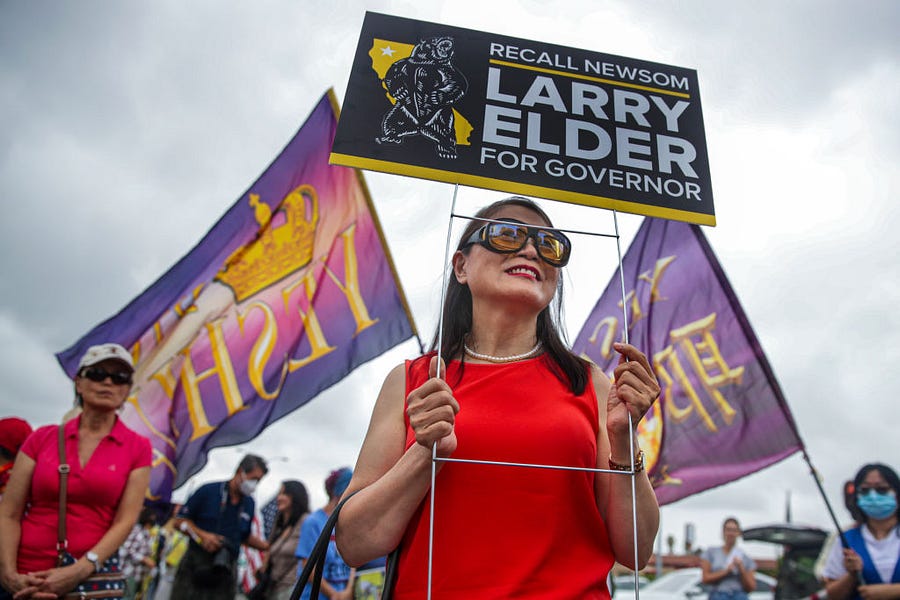Campaign Quick Hits
I asked the guys on the Dispatch Podcast last week what they were looking at as bellwethers as they thought about the 2022 midterms. All of the answers start with R except for one, and despite racking my brain for a good R-word for the Virginia gubernatorial, I never came up with one. Please leave all the ideas I didn’t think of in the comments.
2021 Virginia: Jonah said it wasn’t so much whether the GOP’s Glenn Youngkin could win this November’s election against quasi-incumbent Terry McAuliffe, but how competitive he could be in the Northern Virginia suburbs, which have been turning increasingly darker shades of blue in the last few cycles. Critical race theory in schools has been a big topic in the race, as has rising crime. If these are issues that Republicans think will move House and Senate races across the country next year, we’d want to see some of that shift in Fairfax and Loudon counties this fall.
As of now, the polling is a little all over the place. Roanoke College has McAuliffe 8 points up in their latest poll (with half of voters having no opinion of Youngkin), Virginia Commonwealth University showed McAuliffe 3 points ahead, and Christopher Newport University’s poll has McAuliffe winning by 9. That last poll showed McAuliffe leading Youngkin 59 to 33 percent in those Northern Virginia suburban counties. For this Virginia bellwether to lead the GOP to victory in 2022, I’d want to see Youngkin within 3 points in the state overall and running closer to 10 points behind in those Northern Virginia counties.
And now there’s this lawsuit brought by the Republican Party of Virginia, claiming that McAuliffe never actually signed the declaration of candidacy that his campaign submitted to the Board of Elections. If true, it’s unclear what the courts will do about it this late in the game. They could disqualify McAuliffe and remove him from the ballot or they could just brush it off as a harmless error. But in 2019, a Republican rising star was kept off the ballot for Virginia’s House of Delegates under similar-ish paperwork screw up circumstances.
Regardless, this episode shows how important the much-overlooked ballot access team is in these campaigns. These anal-retentive nerds are responsible for ensuring all the bureaucratic boxes are perfectly checked and deadlines precisely met for signature gathering, witness affidavits, and, arguably the most important, declarations of candidacy.
We’ll see!
Recall: Another race the guys said they were watching was the California recall. As the polling shows a neck and neck race for Democratic Gov. Gavin Newsom against himself, it’s almost hard to remember that he won the job by 24 points in 2018. This is California, after all, a state that President Joe Biden won by 29 points less than a year ago. And yet …
Polling is of limited value in a race like this. Remember that voters will first be asked to decide whether to recall Newsom and then—separately—who they want to replace him if the recall passes. And it’s very hard to figure out who will actually show up to vote. But as of now, it looks like a tight race. Earlier this month, a CBS News/YouGov poll had the no-recall beating recall by 4 points.
So why is this a bellwether of anything except a politically lopsided state with a governor who couldn’t resist skirting his own public health guidance to dine out with lobbyists during a worldwide pandemic? Turnout. There’s no real question that if everyone in California voted, Newsom would stay put with votes to spare. But if he gets recalled, it will be because turnout on the right was through the roof, voters on the left didn’t care enough to show up, and independent voters turned against Newsom for any number of reasons that will all still be on the ballot in 2022.
Vice President Harris had to cancel her campaign trip to help Newsom in the wake of the deadly suicide bombing in Afghanistan. Bernie Sanders, who won the state’s primary in 2020, released an ad arguing that “at this unprecedented moment in American history, when we’re trying to address the crisis of climate change, guarantee health care for all and pass real immigration reform, the last thing we need is to have some right-wing Republican governor in California.” Fair nuff. Let’s see if it works.
Retirements: Another topic we raised was retirements. As we look at the Senate, Republicans only need to pick up one seat with New Hampshire, Georgia, and Arizona at the top of their list. But they also have to hold all of their current seats. That’s going to be hard enough with open seats to defend in Pennsylvania, Ohio, and North Carolina. And there could be more.
We still don’t know whether GOP Wisconsin Sen. Ron Johnson will retire—a seat that will be very hard for Republicans to hold without him (and maybe hard to hold with him as well). Ditto Iowa Sen. Chuck Grassley. Alaska Sen. Lisa Murkowski could also decide not to run, and the state’s ranked choice voting could give Democrats a fighting chance for a pickup there. There’s also South Dakota Sen. John Thune, who has been repeatedly attacked by President Trump and could face a bruising primary. He voted against the infrastructure deal, though, which feels like a sign that he intends to run and move to the right to beat out any GOP challengers.
And watch out for some of those Dem retirements on the House side. They’re starting to pile up. If you only looked at this metric of retirements, you’d predict that Republicans would win the House and Democrats would maintain control of the Senate—and maybe pick up a seat or two.
Redistricting: It’s getting harder to see a path for Democrats to keep the House after 2022, but one last hope is redistricting. Now that we have the block data that will be used to redraw the lines, we can start thinking more clearly about who the new census data will benefit and hurt. Remember that Texas is adding two seats; Colorado, Florida, Montana, North Carolina and Oregon will each add one; and California, Illinois, Michigan, New York, Ohio, Pennsylvania and West Virginia will each lose one.
Texas lines are drawn by the Republican-controlled legislature, so they will be looking for a way to give Republicans a way to pick up both new districts. But that’s easier said than done. Not only are there hilariously complex legal hurdles to overcome when drawing lines with substantial minority populations, but they also need to find a way to deal with the now-overstuffed districts in Houston and Dallas and get them all to around 763,000 people, all while protecting their current incumbents’ districts.
On the flip side, a Democratic-controlled state like Illinois that is losing a seat will almost certainly cost the Republicans one. GOP Rep. Adam Kinzinger’s exurban Chicago district is on the chopping block, which Politico covered in depth in a piece charmingly headlined “How Screwed is Adam Kinzinger.” Not only would this mean that Republicans need to find another pickup opportunity elsewhere on the map, it’s also another example of why moderates in Congress have moved from the endangered list to the brink of extinction.
For more on which seats are likely to change, check out Roll Call’s handy list here.
Recruitment: Retirements and redistricting lead to open seats, and that means it’s recruitment season. And as Calvin Moore, communications director of the Congressional Leadership Fund—the House GOP super PAC—told the Deseret News this month, “In 2020, every seat Republicans flipped was won by a woman, a minority, a veteran, or in some cases, a combination of all three.” That doesn’t happen by accident: It takes party operatives months at the local and state level, talking to community leaders, finding potential candidates, and then convincing them to throw their hats in the ring.
On the House side, it can mean scouring the countryside for your Cinderella, but on the Senate side, candidate recruitment is more high-profile. In New Hampshire, Democratic Sen. Maggie Hassan won her seat in 2016 by only about 1,000 votes, making it the prime pickup opportunity for Republicans—if they can find a candidate who can take her down. Republican Governor Chris Sununu, son of former governor and White House chief of staff John H. Sununu and brother of former senator John E. Sununu, is playing the role of Hamlet. As Slate noted, “Mitch McConnell and NRSC chair Rick Scott are practically camped outside his home begging him to run for Senate,” but he says he won’t make a decision until the winter—thereby freezing the field in the meantime. If he doesn’t run, it will be seen as a huge recruiting failure for the GOP and make it very difficult for another candidate to get his or her act together with such a short runway.
And now for some Chris genius on that recall effort.
You Win Some, You Newsom
I suspect that California Gov. Gavin Newsom will still probably survive the Republican-backed recall election that aims to make him the second of the past four Golden State governors to be booted from office. But if the polls showing him dangerously close to removal—just 4.3 points above water, according to the FiveThirtyEight average—do portend disaster for the San Francisco Democrat, he can at least partly blame his and his party’s affection for mail-in voting.
Yes, his lack of a compelling message beyond “Republicans are scary and terrible” would also be a factor, as would the decades-long slouch toward paralysis (in considerable part because of out-of-control public sector unions) that makes California nearly ungovernable. But conducting a recall election by mail is even crazier than a normal recall election, which is already kind of nuts itself.
In a republican system of divided powers, the legislature is the safeguard against bad executives. Lawmakers can isolate, defund, impeach, or remove chief executives who fail to live up to their oaths of office. But back in 1913, when California was a hotbed of Teddy Roosevelt-style flaming-sword progressivism, the state’s constitution was amended to allow petition drives to force recall elections of officials. These were the days when progressives also wanted court decisions to be subject to review by popular vote—any cause for more direct democracy and fewer guardrails.
But while there have been 179 recall petition drives in the state since then, only 11 times have organizers gathered enough signatures to force a vote, and only six times was the vote successful: thrice for the state Senate, twice for the state Assembly, and once for governor—the aptly named Gray Davis in 2003. Though the numbers of successful recalls have remained relatively low, the frequency of the attempts has been growing. Nine of the past 11 governors have faced a recall. This is Newsom’s sixth.
It is, of course, a terrible way to govern a state. If office holders don’t even have the two or four years allotted to them in a term to actually try to do their work before standing for re-election, how could anyone ever summon the will to do necessary but unpopular things? Indeed, much of what makes California such a basket case is too much direct democracy. Not only are governors afraid to think about even medium-term considerations, easy-access referenda rules mean voters can set contradictory goals for the government.
But the Newsom recall is wild even by California standards.
Under pandemic election rules, county election officials two weeks ago started mailing out recall ballots to every one of California’s more than 22 million registered voters. Voters have until two weeks from today, Sept. 14, to get their ballots in the mail. They will have to answer two questions: Should Newsom be removed from office? If he is, which certified candidate should replace him?
If more than half of voters want Newsom out, the top finisher would be sworn in on Oct. 22 and serve the final 14 months of the current term. In reality, though, he or she would have to start running for their November, 2022 re-election immediately. The Republican frontrunner is talk-radio host Larry Elder, who is far ahead of the other members of the red team. He is polling at something like 20 percent of the vote in a 46-person field. If Newsom is soundly removed with, say, 47 percent of voters supporting his retention, he could be replaced by someone with support of less than a quarter of voters. Elder, though a lawyer by training, has never held public office. Nor is there a ready bench of experienced Republican former or current officials in the state from which he could quickly assemble an administration. He would face maximum resistance from the heavily Democratic legislature. He would do it all while Democrats were preparing their 2022 onslaught against him. Urp.
That all really might happen. If it does, California Democrats will have to partly blame their crazy combination of direct democracy and convenience voting.
Even before the coronavirus pandemic, the state had been moving toward an all-mail elections regime. Any voter could cast their ballot by mail, and with just one check of a box on a form, anyone could obtain permanent vote-by-mail status in which they automatically receive a ballot in their mailboxes. When the pandemic emerged, California quickly embraced a universal-mail election system—a decision no doubt made easier by their mistaken belief in the myth that high turnout benefits the blue team.
Instead, what they have done is establish a system in which every registered voter in California will receive a solicitation to participate in the effort to recall the Democratic governor. The 2003 recall election was a massive national news story for weeks. Davis was hugely unpopular thanks to a summer of rolling blackouts and his plan to plug the state’s budget gap by tripling car registration fees. Her was also facing a famous, charming movie star, Arnold Schwarzenegger, as the leading potential replacement. Schwarzenegger was also a moderate Republican, not a conservative like Elder. That election drew out 9.4 million voters – about 61 percent of those eligible.
Californians left, right, and center are certainly frustrated with Newsom’s whipsawing response to coronavirus and limousine liberalism, not to mention the general decline of the state, which has experienced its first-ever loss of a congressional seat because of a stagnant population. But he’s nowhere near as unpopular as Davis. In part because of that, and in part because of the lack of a box-office draw like Der Governator, this recall would have probably been a lower turnout affair. That certainly would have given the advantage to Democrats, who could previously rely on the aforementioned government worker unions and other interest groups to dominate in off-year, low-turnout elections.
But with elections officials directly soliciting 22 million voters to participate, who knows what might happen? If 61 percent participated again this time, that would be 13.4 million ballots. And that would certainly include plenty of voters who wouldn’t want Elder to replace Newsom, but might not like Newsom. It’s no coincidence that Newsom is enlisting Sen. Bernie Sanders to help fight off the recall. The target voter is an apathetic Bernie bro who dislikes the slick, corporatist Newsom and might check the box for recall without understanding the consequences.
Newsom will probably beat the rap next month, but if he doesn’t, Democrats should partly blame too much direct democracy and convenience voting.










Please note that we at The Dispatch hold ourselves, our work, and our commenters to a higher standard than other places on the internet. We welcome comments that foster genuine debate or discussion—including comments critical of us or our work—but responses that include ad hominem attacks on fellow Dispatch members or are intended to stoke fear and anger may be moderated.